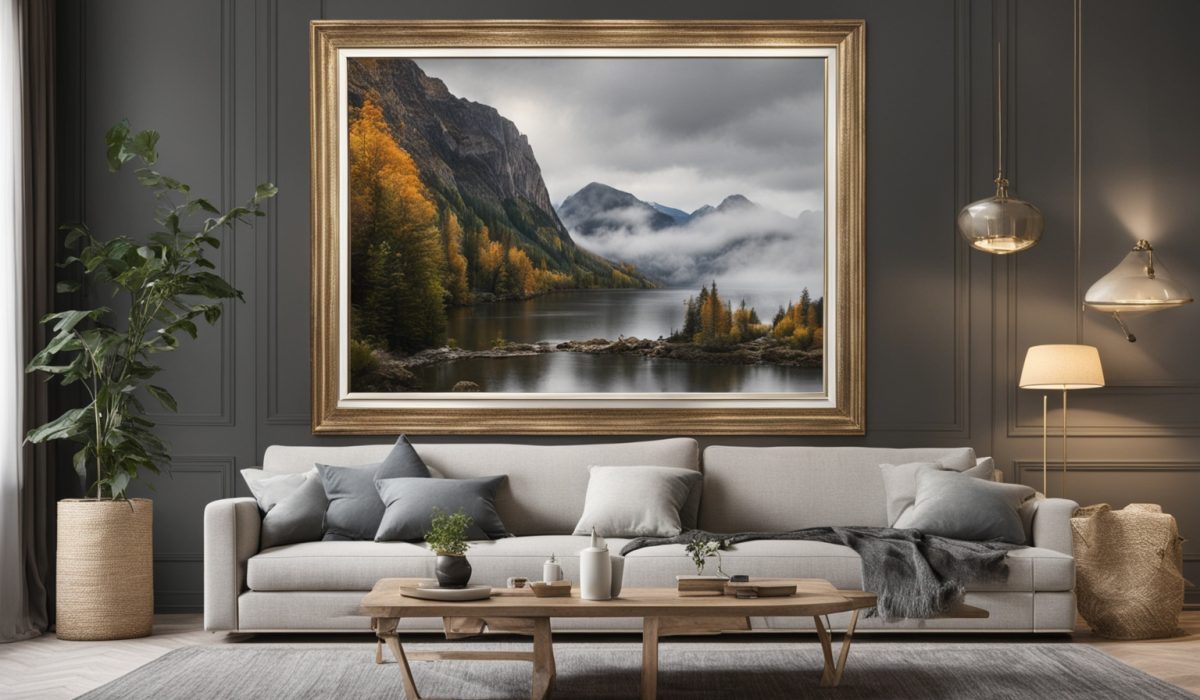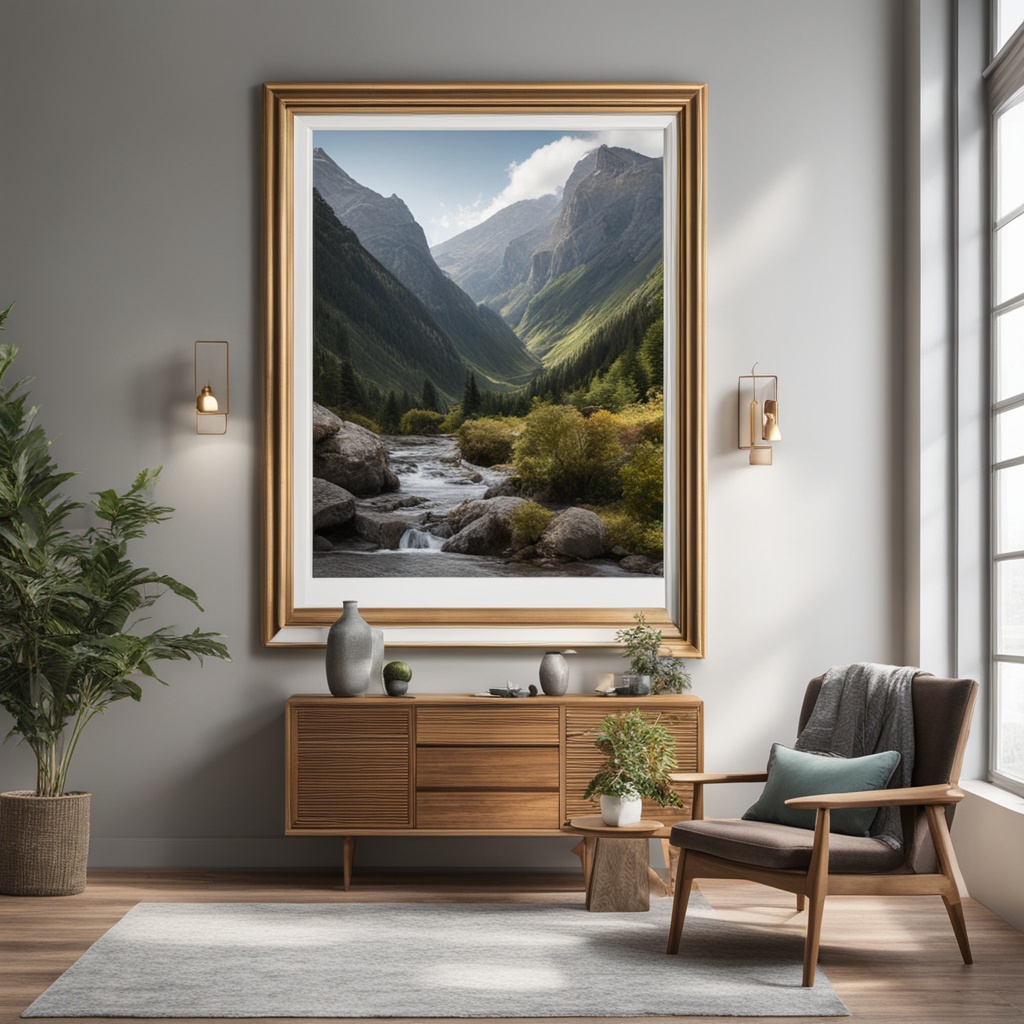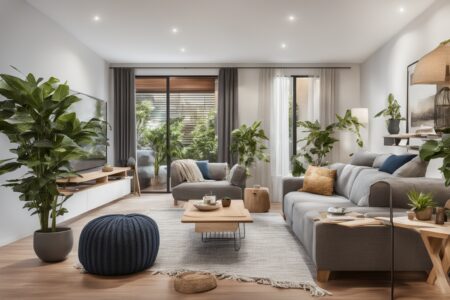Enhancing Your Space with Framed Wall Paintings: Tips & Ideas

Framed wall paintings are more than just art; they are a reflection of personal style and a tool for transforming any space into a vibrant, engaging environment. The journey begins with choosing the right frame style that complements both the artwork and your interior design. Once you have the perfect frames, the next step is to select the artworks that resonate with your aesthetic sense and align with the atmosphere you wish to create. The placement of these framed pieces can greatly influence the room’s ambiance, be it through strategic positioning to catch the light or enhancing the colours of your room decor. Speaking of lighting, ensuring your artwork is properly illuminated can enrich the visual impact of the painting’s details and colours. Additionally, experimenting with various sizes and orientations, or even creating thematic gallery walls, can provide a dynamic and personalised touch to your interiors. To ensure longevity, understanding the maintenance and care for your framed art is crucial. All these elements contribute to maximising the beauty and impact of framed wall paintings in your home or office space, allowing you to revel in a creatively enriched environment.
CONTENT
Introduction to Framed Wall Paintings
The Origins of Framed Wall Paintings
Framed wall paintings have been a central component of interior design for centuries, evolving from simple, functional items to intricate works of art that signify status, culture, and personal taste. Initially used to protect and highlight the artwork, frames have grown to play a pivotal role in the presentation and preservation of paintings, enhancing both their appeal and durability.
The Functionality of Frames
Beyond aesthetics, frames serve crucial functional purposes. They help in preserving the artwork from environmental factors such as moisture and dust, which can degrade the quality over time. Frames also provide structural support, particularly for canvas artworks, ensuring that the piece remains stretched and does not succumb to warping or other forms of distortion.
Modern Trends in Framed Wall Paintings
In contemporary settings, the choice of frames and their stylistic applications vary widely, reflecting modern trends and innovations in interior design. Today, frames are not just about preservation and support but also about making a style statement. From minimalist designs to eclectic mixes, framed wall paintings create focal points in modern homes and offices, enhancing spaces with a mixture of tradition and trend.
Choosing the Right Frame Style
When choosing the right frame style for your wall paintings, the first consideration should often be the overarching design theme of the space where the artwork will be displayed. Traditional spaces generally benefit from classical frame designs featuring ornate details and rich finishes such as gold or mahogany. Conversely, modern spaces tend to pair well with sleek, simple frame styles that embrace minimalism, using materials like metal or plain wooden frames with unobtrusive finishes.
Another key element in selecting a frame is the artwork itself. Frames should complement the painting, not compete with it. For lively, busy artworks, a simple frame can help the viewer’s eye focus on the art rather than the frame. On the other hand, a more ornate frame might be suitable for a simple or monochromatic painting to enhance its presence in a room. It’s important to consider the scale of the artwork too; a heavier, larger frame may overwhelm a delicate piece, while a too-thin frame might not provide adequate support or visual weight for a larger painting.
Lastly, consider the material and colour of the frame, as these can have significant impacts on both the art and the space around it. Frames in natural wood tones can bring warmth to a room, while metallic ones can add a modern touch. The colour should harmonise with other elements in the room but can also be used to make a statement or add contrast. Keep in mind the glass or acrylic front used in framing, especially if your artwork will hang in a space with a lot of light, as non-reflective or UV light-filtering options can help preserve the art underneath.
Selecting Artworks for Your Frames
Assessing the Theme and Mood
When selecting artwork to frame, it is crucial to consider the overall theme and mood you intend to convey within the space. Artwork can set the tone of a room and should align with the existing decor and atmosphere. Whether you are aiming for a calming, serene setting with subtle watercolours or seeking a vibrant, energetic mood with bold abstract pieces, the artwork you choose will significantly contribute to the ambience of the area.
Understanding Scale and Proportion
The scale of the artwork in relation to the frame and the room it inhabits is an essential factor in creating visual harmony. A large painting in a small room can feel overwhelming, whereas small artworks in a vast space often look lost and understated. Aim for a balanced proportion that complements the room’s dimensions, and ensure the frame size appropriately accentuates the artwork without dominating it.
Colour Considerations in Art Selection
Colour plays a pivotal role in selecting suitable artwork for framing. It’s important to consider how the colours within the artwork will interact with the room’s colour scheme. Artworks that echo the accent colours in your decor can create a cohesive look, while contrasting colours can serve as a striking focal point. Additionally, the colour temperature of the artwork can influence the perceived warmth or coolness of the space, enhancing the overall aesthetic appeal.

Ideal Placement of Framed Paintings
Selecting the ideal spot for your framed paintings involves considering several factors for optimal visual impact. Firstly, the height at which artwork is hung plays a significant role. Artworks should generally be placed at eye level, which typically means the centre of the painting should be about 145 to 150 centimetres from the floor. This height gives the artwork a more personalised interaction with viewers, making it easier to appreciate both from a distance and up close. However, adjustments may be necessary depending on ceiling heights and the specific layout of the room.
When thinking about the placement of framed paintings relative to furniture, consider the coherence between the artwork and the room’s arrangement. A common practice is to hang artwork approximately 15 to 25 centimetres above the top of a sofa or other furniture, which helps connect the art visually with nearby items without overwhelming them. It’s crucial that the artwork is not too wide; ideally, it should be about two-thirds to three-quarters the width of the furniture over which it hangs. This principle helps maintain balance and proportion in the room’s composition.
Lighting also dramatically affects how framed paintings are viewed and should be a key consideration in placement. Natural light can showcase the true colours and details in a painting, but direct sunlight can cause damage over time. Artificial lighting, such as spotlighting, can be used to enhance and draw attention to the artwork. When positioning paintings, aim to avoid placement opposite large windows that produce a lot of glares, but rather in areas where the light complements the visibility and vibrancy of the artwork’s colours without risking damage.
Colour Coordination with Room Decor
Matching Colour Schemes
Effective colour coordination between framed paintings and room decor begins with understanding the existing colour scheme of the space. For rooms dressed in neutral tones, artwork featuring bold and bright colours can serve as stunning accent pieces that add vibrancy and character. Conversely, in a room where vibrant hues dominate, choosing artwork with soft, muted colours can bring balance and subtlety, preventing the space from becoming visually overwhelming.
Using Colour Psychology
Colour psychology can be a powerful tool in selecting artworks that enhance the emotional and psychological impact of a room. Colours like blue and green tend to evoke feelings of calm and relaxation and might be perfect for living spaces or bedrooms. In contrast, reds and yellows can energise a space, making them ideal for areas like the kitchen or a home office. Framed paintings chosen with colour psychology in mind can significantly influence the mood and atmosphere of a space.
Harmonising Art and Decor Accessories
To create a cohesive interior design, consider how the colours in your framed paintings interact with other decorative elements in the room, such as cushions, rugs, and curtains. If your artwork contains hints of gold, incorporating decorative accessories in similar hues can unify the space. Conversely, if your frame or artwork features a particularly striking colour, echo this shade in smaller decor elements throughout the room to tie the space together visually and create a harmonious aesthetic.
Lighting Your Framed Wall Paintings
Lighting can dramatically transform the appearance of framed wall paintings, highlighting their finest details and enhancing their colours. When considering how to light your artwork effectively, the type of lighting plays a crucial role. LED lights are often recommended due to their low UV radiation and the minimal heat they emit, which helps in preserving the artwork’s integrity over time. Directional ceiling lights, track lighting, or wall-mounted lights can be adjusted to focus on the painting, ensuring that it is illuminated without creating unwanted glare or shadows.
The angle and intensity of lighting are also important factors to consider. Ideally, lights should be positioned at a 30-degree angle to reduce glare and provide even coverage across the surface of the painting. This angle can be adjusted slightly to avoid casting a shadow if the frame has a deep rabbet. Using dimmable lights offers flexibility, allowing you to adjust brightness according to the time of day and the ambient light available in the room, which helps in maintaining the true colours and details of the artwork.
Moreover, the colour temperature of the lighting can affect how the colours in the painting are perceived. Warmer lights tend to enhance reds and yellows, creating a cosy atmosphere, while cooler lights can make blues and greens more vibrant, providing a crisper visual effect. It’s beneficial to experiment with different colour temperatures to see which best accentuates the hues in your framed wall paintings, and subsequently elevates the overall aesthetic of the room.
Mixing Sizes and Orientations
Varying Frame Sizes
Introducing a variety of frame sizes into your decor can create a dynamic visual interest and rhythm within the space. Start with selecting one or two larger pieces as focal points and augment these with smaller frames to maintain balance. This size variation can draw the eye across the room in a natural, flowing manner, leading to a more engaging and layered aesthetic. It’s crucial to maintain some degree of consistency in frame style or colour to unify the collection, despite the differences in size.
Combining Horizontal and Vertical Orientations
Mixing different orientations can add an element of surprise and break the monotony of a gallery wall. When blending horizontal and vertical frames, consider the overall symmetry and balance of the display. Position larger frames centrally and surround them with smaller ones, alternating orientations to create a pleasing yet unexpected arrangement. This technique not only fills the wall more completely but also caters to various artwork sizes and shapes, enhancing the gallery’s appeal.
Creating Depth with Layering
Layering framed artworks by placing smaller frames in front of larger ones can create a sense of depth and texture within your display. This can be particularly effective on shelving or mantelpieces where physical depth is available. By slightly overlapping frames or setting some pieces forward, you generate a three-dimensional look that adds to the richness and sophistication of the arrangement. Ensure that each piece remains visible and consider the overall composition to achieve a harmonious yet lively display.
Creating Thematic Gallery Walls
Creating a thematic gallery wall can be an exciting way to tell a story or express a specific concept through framed art. Begin by deciding on a theme that resonates with your personal interests or complements the existing decor. This could range from a nature-inspired theme incorporating floral and landscape paintings, to a more abstract or contemporary collection focusing on geometric patterns and vibrant colours. Consistency in the theme will ensure that the gallery wall feels cohesive and thoughtfully curated rather than randomly assembled.
Once the theme is set, layout planning becomes critical. Arrange the artworks on the floor before fixing them to the wall. This step allows you to experiment with different configurations to see how the pieces interact with each other. Consider maintaining a consistent spacing between frames, typically about 5 to 10 centimetres, to create uniformity. However, for a more eclectic look, you might vary the spacing and alignment, enabling each piece to stand out on its own while still contributing to the overall theme.
In addition to physical arrangement, the choice of frames can further enhance the thematic connection between the artworks. Choosing frames with a similar style or colour can unify pieces from different periods or styles, reinforcing the theme. Alternatively, using distinctly different frames might highlight the unique character of each piece, adding a lively diversity to your thematic gallery wall. This approach allows each artwork to contribute its voice to the chosen theme, enriching the room’s narrative and aesthetic appeal.
Maintenance and Care for Framed Art
Regular Cleaning Techniques
Maintaining the pristine condition of framed art starts with regular cleaning. Dust framed paintings gently using a soft, dry microfiber cloth or a soft brush to avoid scratching the glass or frame. For glass-covered artwork, you can use a glass cleaner, but ensure the liquid doesn’t seep into the frame or behind the glass, as this can damage the artwork. Spraying the cleaner onto the cloth instead of directly onto the glass reduces this risk and helps maintain the integrity of the frame and art.
Preventing Environmental Damage
Environmental factors such as sunlight, humidity, and temperature variations can significantly affect the longevity of framed art. To protect your frames and paintings, avoid hanging them where they will be exposed to direct sunlight, which can fade colours and degrade materials. Maintain a stable environment with controlled humidity levels to prevent warping or mould growth. Using UV-protective glass can also help mitigate light damage, preserving the vibrancy and details of the artwork for years to come.
Professional Care and Restoration
For high-value or antique framed artworks, professional care and occasional restoration may be necessary to preserve their condition and value. Consulting with art conservation professionals can provide insights into the specific needs of your artwork, including the best climate conditions and cleaning methods. If a painting shows signs of damage, such as flaking paint or water stains, professional restoration can often reverse much of this damage and prevent further deterioration, securing the artwork for future enjoyment and potential appreciation in value.
Conclusion and Final Thoughts on Using Framed Paintings
Framed paintings are not merely decorative elements; they are transformative entities that convey expression, evoke emotions, and enhance the aesthetic appeal of any room. They offer a unique opportunity to personalise space and allow individuals to express their tastes and interests creatively. Whether through a meticulously curated gallery wall or a single statement piece, the art you choose and how you frame it can articulate the ambiance and ethos of your surroundings with profound impact.
The act of selecting the right frames, arranging them thoughtfully, and maintaining them diligently underscores a commitment to not only the art itself but also to creating a cohesive and inviting environment. It is important to approach the placement of each piece with consideration of lighting, colour harmonies, and the overall layout of the space. These factors collectively contribute to the way artworks interact with their environment, promoting a harmonious balance that enhances both the art and the room it inhabits.
Ultimately, framed paintings offer a dynamic and flexible way to enrich living or working spaces, making them more vibrant and reflective of personal or corporate identities. By understanding the nuances of choosing, placing, and caring for framed paintings, one can effectively optimise their impact and enjoyment, ensuring that these art pieces not only decorate a wall but also define and elevate the spaces they occupy.






